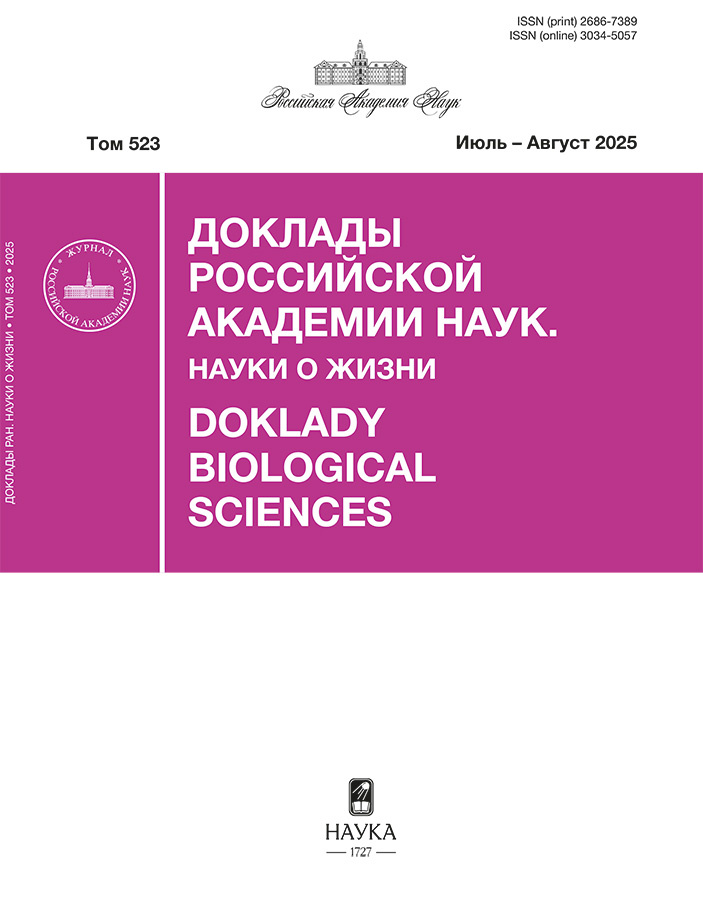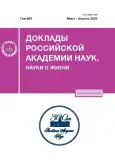Rhinolophus mehelyi scythotauricus subsp. nov. (Rhinolophidae, Chiroptera) из нижнего плейстоцена пещеры Таврида в Крыму
- Авторы: Лопатин А.В.1
-
Учреждения:
- Палеонтологический институт им. А.А. Борисяка Российской академии наук
- Выпуск: Том 509, № 1 (2023)
- Страницы: 109-114
- Раздел: Статьи
- URL: https://journals.rcsi.science/2686-7389/article/view/135630
- DOI: https://doi.org/10.31857/S2686738922600947
- EDN: https://elibrary.ru/NAQJQC
- ID: 135630
Цитировать
Полный текст
Аннотация
По неполному черепу из нижнеплейстоценовых отложений пещеры Таврида в центральном Крыму описан новый вымерший подвид подковоносов Мегели, Rhinolophus mehelyi scythotauricus subsp. nov., самый крупный представитель группы R. euryale. По эволюционному уровню он занимает промежуточное положение между плио-плейстоценовым R. mehelyi birzebbugensis Storch, 1974 и современными представителями вида, но его крупные размеры и относительно узкие верхние моляры могут свидетельствовать о принадлежности к особой филогенетической линии в пределах R. mehelyi Matschie, 1901. R. mehelyi scythotauricus subsp. nov. является первой ископаемой находкой вида в Крыму; также это одна из наиболее северных находок R. mehelyi.
Ключевые слова
Об авторах
А. В. Лопатин
Палеонтологический институт им. А.А. Борисяка Российской академии наук
Автор, ответственный за переписку.
Email: alopat@paleo.ru
Россия, Москва
Список литературы
- Лопатин А.В. Раннеплейстоценовый подковонос Rhinolophus macrorhinus cimmerius subsp. nov. (Rhinolophidae, Chiroptera) из пещеры Таврида в Крыму // Доклады Российской академии наук. Науки о жизни. 2022. Т. 506. С. 396–405.
- Лопатин А.В. Раннеплейстоценовый кожан Eptesicus praeglacialis (Vespertilionidae, Chiroptera) из пещеры Таврида в Крыму // Доклады Российской академии наук. Науки о жизни. 2023. Т. 508. С. 95–104.
- Лопатин А.В., Вислобокова И.А., Лавров А.В. и др. Пещера Таврида – новое местонахождение раннеплейстоценовых позвоночных в Крыму // Доклады Академии наук. 2019. Т. 485. № 3. С. 381–385.
- Лопатин А.В., Тесаков А.С. Раннеплейстоценовая белозубка Crocidura kornfeldi (Lipotyphla, Soricidae) из Крыма // Доклады Российской академии наук. Науки о жизни. 2021. Т. 501. № 1. С. 499–504.
- Topál G., Csorba G. The subspecific division of Rhino-lophus luctus Temminck, 1835, and the taxonomic status of R. beddomei Andersen, 1905 (Mammalia, Chiroptera) // Miscellanea Zoologica Hungarica. 1992. V. 7. P. 101–116.
- Gunnell G.F., Eiting T.P., Geraads D. New late Pliocene bats (Chiroptera) from Ahl al Oughlam, Morocco // Neues Jahrbuch für Geologie und Paläontologie. Abhandlungen. 2011. V. 260. № 1. P. 55–71.
- Curtis A.A., Simmons N.B. Unique turbinal morphology in horseshoe bats (Chiroptera: Rhinolophidae) // The Anatomical Record. 2017. V. 300. № 2. P. 309–325.
- Curtis A.A., Smith T.D., Bhatnagar K.P., et al. Maxilloturbinal aids in nasophonation in horseshoe bats (Chiroptera: Rhinolophidae) // The Anatomical Record. 2020. V. 303. № 1. P. 110–128.
- Storch G. Quartäre Fledermaus-Faunen von der Insel Malta // Senckenbergiana Lethaea. 1974. V. 55. P. 407–434.
- Popov V. Pliocene small mammals (Mammalia, Lipotyphla, Chiroptera, Lagomorpha, Rodentia) from Muselievo (North Bulgaria) // Geodiversitas. 2004. V. 26. № 3. P. 403–491.
- Crespo V.D., Sevilla P., Mansino S., et al. Bats from the classical site of Venta del Moro (Late Miocene, Eastern Spain) // Historical Biology. 2018 (2017). V. 30. № 3. P. 317–326.
- Heller F. Eine oberpliocäne Wirbeltierfauna aus Rheinhessen // Neues Jahrbuch für Mineralogie, Geologie und Paläontologie. Abteilung B. 1936. V. 76. P. 99–160.
- Wołoszyn B.W. Pliocene and Pleistocene bats of Poland // Acta Palaeontologica Polonica. 1987. V. 32. № 3–4. P. 207–325.
- Horáček I., Maul L.C., Smith K.T., et al. Bat remains (Mammalia, Chiroptera) from the Middle Pleistocene site of Qesem Cave, Israel, with the first Pleistocene record of fruit bats in the Mediterranean region // Palaeontologia Electronica. 2013. V. 16. № 3 (23A). P. 1–19; palaeo-electronica.org/content/2013/513-qesem-bats.
- Salari L., Agnelli P., Calcagnile L. The fossil bat assemblages from the Grotta dei Pipistrelli in Pantalica (southeastern Sicily, Italy): chronological and palaeoecological implications // Comptes Rendus Palevol. 2019. V. 18. № 4. P. 417–441.
- Pazonyi P., Trembeczki M., Mészáros L., Szentesi Z. Preliminary report on the Early Pleistocene vertebrate sites of Beremend Crystal Cave (Beremend 16, South Hungary) and on their palaeoecological importance // Fragmenta Palaeontologica Hungarica. 2019. V. 36. P. 115–140.
- Dietz C., von Helversen O., Nill D. Bats of Britain, Europe and Northwest Africa. London: A&C Black, 2009. 399 p.
- Dondini G., Tomassini A., Inguscio S., Rossi E. Rediscovery of Mehely’s horseshoe bat (Rhinolophus mehelyi) in peninsular Italy // Hystrix. Italian Journal of Mammalogy. 2014. V. 25. № 1. P. 59–60.
- Csősz I., Jére C., Bücs S., et al. The presence of Mehely’s horseshoe bat Rhinolophus mehelyi in South-Western Romania // North-Western Journal of Zoology. 2015. V. 11. № 2. P. 351–356.
- Иваницкий А.Н. Подковонос Мегели Rhinolophus mehelyi Matschie, 1901 // Красная книга Российской Федерации. 2 изд. Москва: ФГБУ ВНИИ Экология, 2021. С. 942–943.













